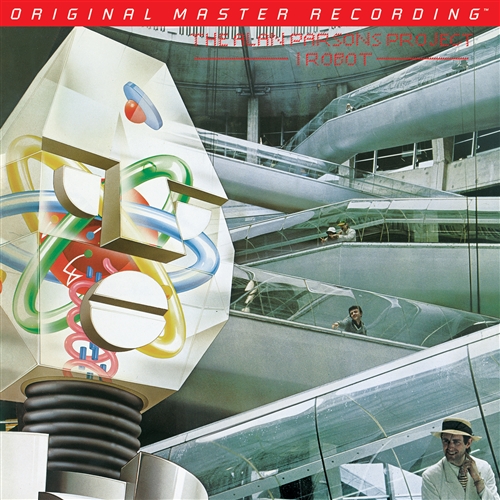The very prolific and talented Grammy favorite Alan Parsons produced I Robot as his own second album in 1977, the same year Star Wars was unleashed upon our collective psyche. As the conceptualization of the album was based on the Robot Trilogy novel series of the Grand Master of the genre himself, Issac Asimov, it was perhaps sheer providence when both Alan Parsons and George Lucas were making their way in the science fiction world, producing their masterpieces.
But this is music from the seventies, whether any of us really find the lyrics as compelling as say “Sheep” by Pink Floyd is debatable. Hollywood writers impose human values and fallacies into the machines and then make them genocidal. In the end, those films fell short by making the robot more human-like and thus less believable. Then again, how else can a Hollywood producer make us relate to a mechanical antagonist?
So, I Robot is not to captivate its audience with words of contemplated political outcries but with sheer musical force. It was the days of showmanship even for Alan Parsons back in the seventies, albeit late seventies, and those days of pre-videotapes welcomed more indulgent musical and sonic creativity archived to the vinyl. Young people actually sat still and listened to a whole forty-some minutes of pure sound through a needle-based home stereo system, having to use their imagination to relate to the message being conveyed. But then, cars were fewer and pace of life was more leisurely while life felt no less hectic just the same. Between Hollywood’s need to constantly show films of more shocking effects and our craving for a modicum of normalcy came visionaries like Alan Parsons, who took us to a more manageable, transient reality via his music.
The playing feels more inspired than crafted in execution and that bodes very well with my ears. There are elements of skill-flaunting at times than musical innovation and that’s ok. The man in his younger years could play and then some. British rock of the time carried a different set of methods and sound not used by our American rock stars. Works like track 4, “Breakdown,” feels more rooted in the imperial, seventies social consciousness to me, thus less avant-garde than the rest of the album; and then there is “Don’t let it show,” the very next track that begins with a melancholic organ and carries on with a bit of calculated sense of haste and zeal, which I think is a classic. But there lies a demonstration of instrumentation master class in the forty-one minutes of play time from beginning to end. Hence, at times I Robot sounds a bit too well-mannered and conjures up a time that bore witness to the musical scene after the British Invasion. In fact, the album scored much higher on charts over here than at home.
Three tracks were released as singles but the album induces multiple playing in a day. A modern day digital file of the album will also do justice to the mixing for a continuing spin from beginning to finish. Standard LP cuts the album off mid-point and the 45rpm severs the body into four parts. I have the 24-bit FLAC file of the album and it is sonically superb; but having the $8,950 Fuuga moving-coil cartridge dug into the groove on the SME Oracle 345 tonearm on a vintage Kyocera PL-910 turntable, secured by the A.R.T. Record Clamp, and the $11k Stealth Audio Cables Helios phono cable hurrying the notes to a $42k Pass Labs Xs Phono preamplifier, then the Pass Labs XA200.8 monoblocks driving the $30k Technical Audio Devices Evolution One loudspeakers via the MIT Cables Oracle cables system, is bliss.
The system provided sweeping testimonial to the artist’s evocative and meticulous instrumentation and mixing, and judicious use of effects that made for a musically evocative and spatially refreshing musical experience.
To say the album is a prime specimen of the progressive rock genre is to say the 45rpm format is just ok, for I’d be quicker to believe that Alan Parsons and his team were all high during the composing, recording and mixing sessions so as to achieve the outstanding creativity demonstrated. Then, to be able to hear this level of musicianship on none other than the MOFI 45rpm format is exciting. But I have come to realize an important element in vinyl playback, namely the labor. Born with two hands with ten digits, I never thought of the level of involvement one would experience in handling and playing a vinyl until I put down the Esoteric K-03 remote and started the ritual of running the vinyl through the Audiodesksysteme Glass Ultrasonic Vinyl Cleaner.
For readers living through the seventies and those seeking glimpses into the most brilliant part of pop culture the era had to offer, the I Robot is hard to surpass. In a time when the Concorde was taking to the sky and we could still board a plane with no security checks, perhaps the sheer creativity expressed in I Robot was to be unleashed eventually; it toggles the mind to even fathom what such artistic ingenuity could accomplish in the modern day. Grab this MOFI 45rpm 2-LP Numbered Limited Edition of a seminal artistic milestone before the supply is gone.
System:
ASC TubeTrap (8) Audio Reference Technology Power Distributor Stealth Audio Cables Helios DIN-RCA phono cable MIT Cables Oracle interconnect, speaker and power cable system Fuuga moving-coil cartridge SME Oracle 345 tonearm A.R.T. Graphite Record Clamp Kyocera PL-910 turntable (vintage) Pass Labs Xs Phono stage Pass Labs Xs Preamp Pass Labs XA-200.8 monoblocks TAD Evolution One speakers
- (Page 1 of 1)

